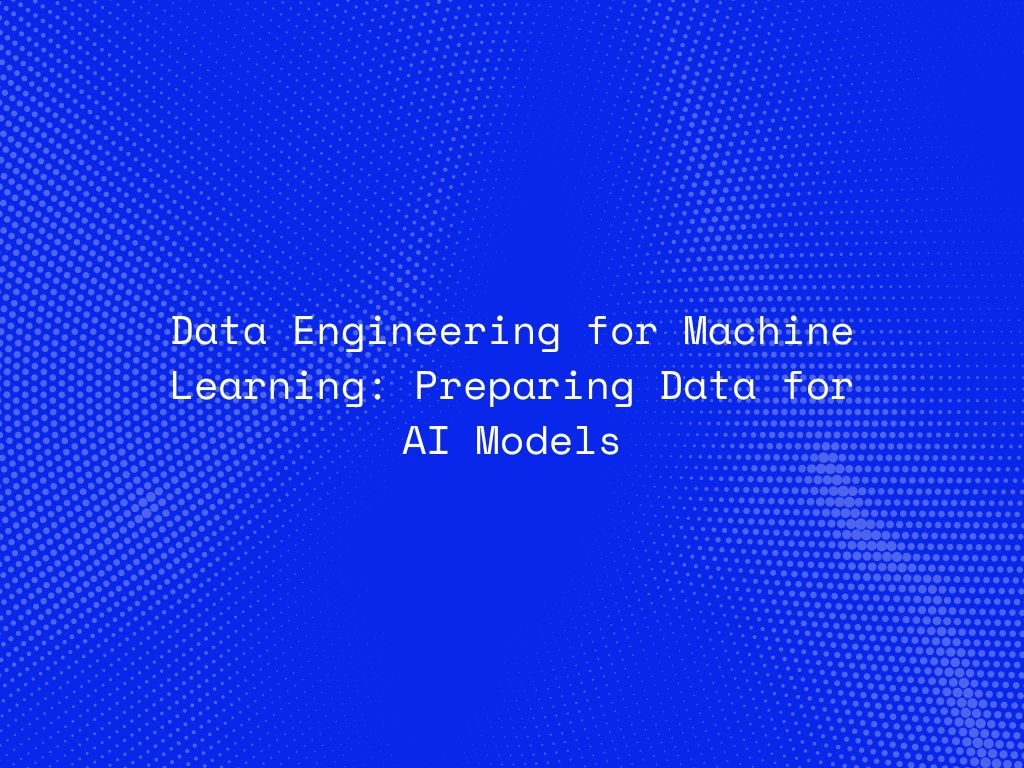In the realm of Machine Learning (ML), the quality and structure of data play a crucial role in determining the success of AI models. Data Engineering is the process of preparing data for machine learning, ensuring it is clean, well-structured, and accessible. This blog explores the key aspects of data engineering for machine learning, highlighting the steps and best practices to prepare data effectively for AI models.
The Importance of Data Engineering in Machine Learning
Data Engineering involves designing, constructing, and maintaining the infrastructure and systems that enable data collection, storage, and processing. Effective data engineering ensures that the data used in machine learning is reliable, accurate, and ready for analysis. Without proper data engineering, even the most advanced ML algorithms cannot produce meaningful insights or predictions.
Key Steps in Data Engineering for Machine Learning
To prepare data for AI models, data engineers follow a series of essential steps:
1. Data Collection
Data Collection is the first step in the data engineering pipeline. This involves gathering data from various sources, such as databases, APIs, sensors, and web scraping. The goal is to collect diverse and comprehensive datasets that can provide valuable insights.
2. Data Ingestion
Data Ingestion refers to the process of importing and transferring data from different sources into a centralized data repository, such as a data warehouse or data lake. This step often involves real-time data streaming or batch processing, depending on the use case.
3. Data Cleaning
Data Cleaning is a critical step that involves identifying and rectifying errors, inconsistencies, and missing values in the dataset. Techniques such as deduplication, normalization, and imputation are used to ensure data quality. Clean data is essential for accurate and reliable ML models.
4. Data Transformation
Data Transformation involves converting raw data into a suitable format for analysis. This may include scaling numerical features, encoding categorical variables, and aggregating data. Transformation ensures that the data is in a consistent and usable form for machine learning algorithms.
5. Data Integration
Data Integration combines data from different sources to create a unified dataset. This step often involves merging datasets, resolving data conflicts, and ensuring consistency across data points. Integrated data provides a holistic view, enabling more comprehensive analysis.
6. Data Storage
Data Storage involves choosing the appropriate storage solutions for the processed data. Depending on the volume and type of data, this may include relational databases, NoSQL databases, or cloud storage. Efficient storage solutions ensure quick access and retrieval of data for model training.
7. Data Pipeline Automation
Data Pipeline Automation involves creating automated workflows to handle data collection, ingestion, cleaning, transformation, and integration. Automation ensures that data processing is consistent, scalable, and repeatable, reducing manual intervention and errors.
Connect With Us
Best Practices for Data Engineering in Machine Learning
To effectively prepare data for AI models, data engineers should adhere to the following best practices:
1. Understand the Data
Thoroughly understanding the data, including its source, structure, and meaning, is crucial. This knowledge helps in making informed decisions during data cleaning, transformation, and integration.
2. Ensure Data Quality
Maintaining high data quality is essential for reliable ML models. Regularly audit and validate data to identify and correct errors, inconsistencies, and anomalies.
3. Implement Robust Data Governance
Data governance involves establishing policies and procedures for data management, security, and privacy. Implementing robust data governance ensures compliance with regulations and protects sensitive information.
4. Use Scalable Infrastructure
Choosing scalable infrastructure, such as cloud-based storage and processing solutions, allows data engineers to handle large volumes of data efficiently. Scalability ensures that the data engineering pipeline can grow with the needs of the organization.
5. Monitor and Maintain Data Pipelines
Regularly monitor data pipelines to ensure they are functioning correctly and efficiently. Implementing monitoring tools and practices helps detect issues early and maintain the integrity of the data processing workflow.
6. Collaborate with Data Scientists
Collaboration between data engineers and data scientists is essential for understanding the specific data requirements for machine learning models. Regular communication ensures that the data prepared meets the needs of the ML algorithms.
The Role of Data Engineering in Model Performance
The performance of Machine Learning models is highly dependent on the quality of the input data. Well-engineered data leads to more accurate, robust, and generalizable models. Key ways in which data engineering impacts model performance include:
- Feature Engineering: Creating relevant features from raw data can significantly improve model accuracy.
- Handling Imbalanced Data: Techniques such as oversampling, undersampling, and synthetic data generation help address class imbalances in the dataset.
- Reducing Overfitting: Clean and well-structured data reduces the risk of overfitting, where models perform well on training data but poorly on new, unseen data.
Conclusion
Data Engineering is a foundational aspect of the machine learning pipeline, ensuring that data is clean, structured, and ready for analysis. By following best practices in data collection, cleaning, transformation, and integration, data engineers can significantly enhance the performance and reliability of AI models. As the volume and complexity of data continue to grow, the role of data engineering in machine learning will become increasingly vital, driving the development of more accurate and efficient AI solutions.




